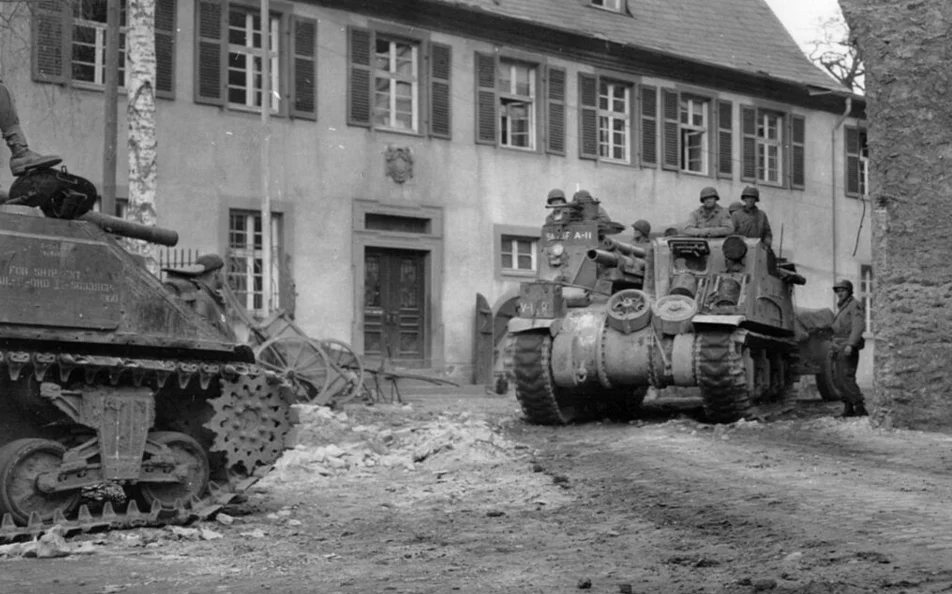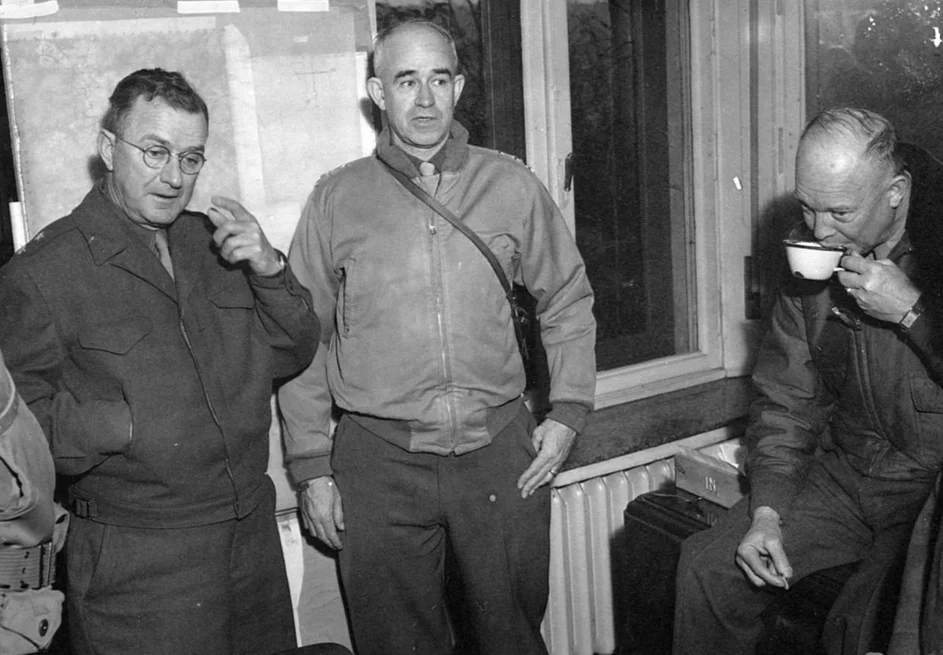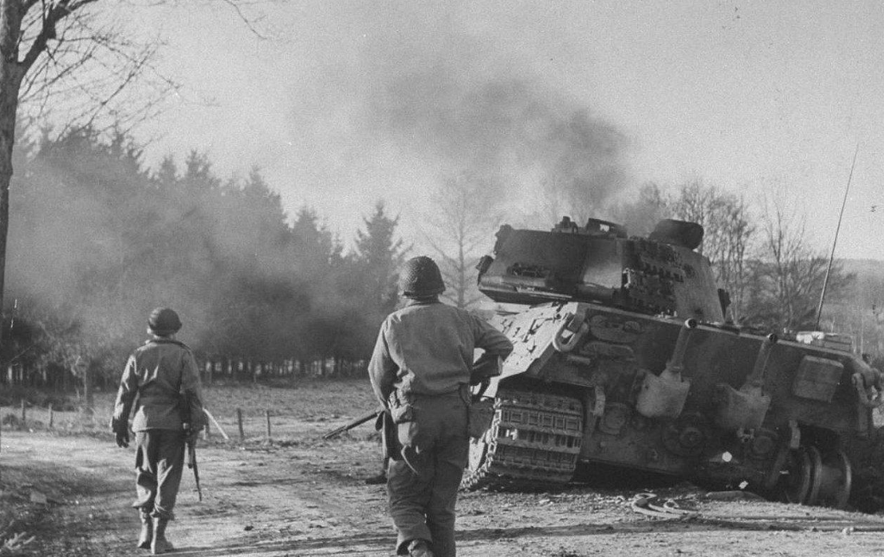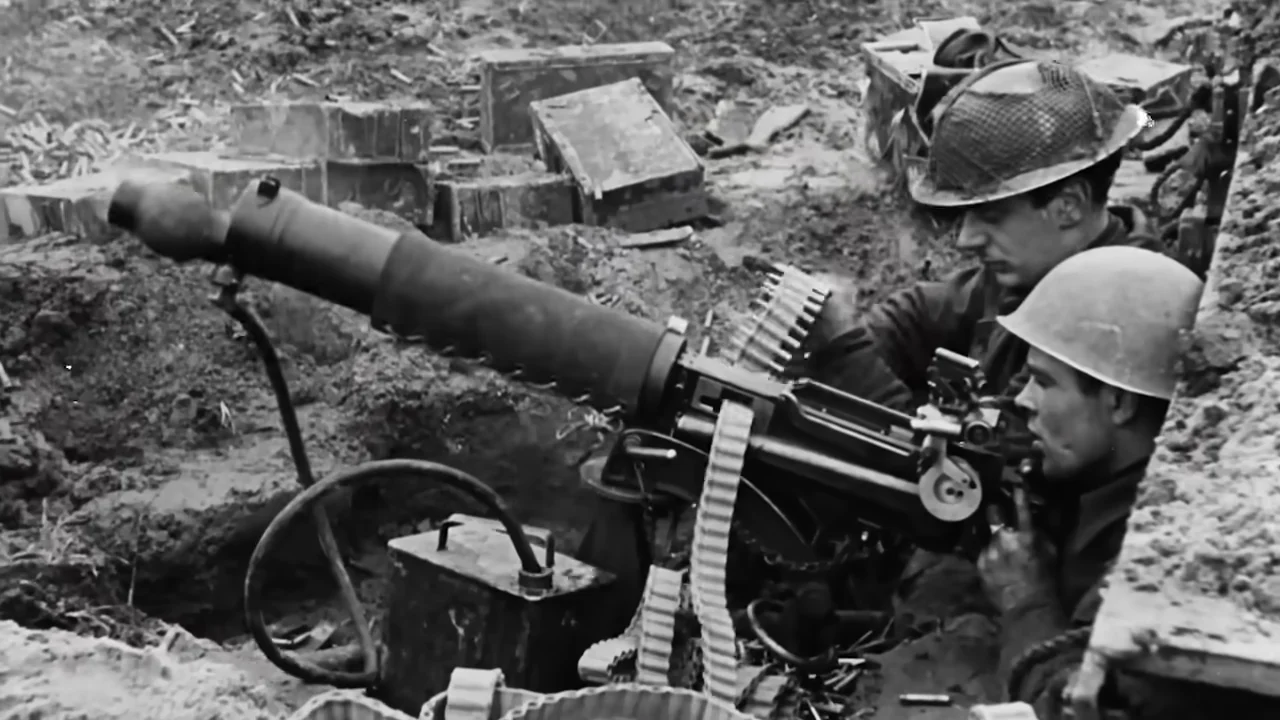The Battle of the Bulge occurred in the densely forested Ardennes region between Belgium and Luxembourg.
This was World War II‘s last major German offensive on the Western Front. The surprise attack began on December 16, 1944, and lasted until January 16, 1945.
For those fascinated by military strategy, the Ardennes offered a challenging landscape. The Germans launched their attack across a roughly 75-mile front line, aiming to divide the Allied forces and seize the initiative.
Winston Churchill called the Battle of the Bulge “the Greatest American battle of the war. ” It was a turning point in the struggle between the Axis and Allied powers.
Understanding the geography is key to appreciating the battle’s complexity. The densely forested terrain and harsh winter conditions played critical roles in unfolding events, making the Battle of the Bulge a compelling study for historians and enthusiasts.
Introduction to the Battle of the Bulge
The Battle of the Bulge was a significant World War II conflict. It marked a major turning point when German forces launched a decisive surprise attack in the Ardennes region but ultimately faced defeat.
What was the Battle of the Bulge?
The Battle of the Bulge was a key military campaign during World War II. It occurred from December 16, 1944, to January 25, 1945.
This battle was a German offensive aimed at dividing the Allied forces, capturing key territories, and forcing a negotiated peace. It was called the Battle of the Bulge because the German troops created a ‘bulge’ in the Allied front lines during the attack.
It was fought in brutal winter conditions in the Ardennes region of Belgium. The German forces initially surprised the Allies.
However, despite early successes, the German army’s lack of resources and the resilience of the Allied forces led to their failure to achieve their objectives. The Allies’ eventual victory set the stage for the final push into Germany.
Historical Context and Significance
Before the Battle of the Bulge, the Allies had made significant progress in liberating Europe from Nazi control. Seeing their retreat, Germany aimed to change the war’s course with this last offensive.
The battle is considered one of the largest fought by the United States Army during the war and highlighted the importance of intelligence and preparation.
This decisive conflict showcased the Allied troops’ endurance and the Germans’ strategic failures. Ultimately, it weakened the German forces significantly, leading to their retreat. The battle’s conclusion hastened the Allied advance into Germany, contributing to the end of the European conflict.
Key Players and Forces Involved
Several key figures played vital roles in the Battle of the Bulge. Adolf Hitler, who planned the operation, led German troops. Field Marshal Gerd von Rundstedt was instrumental in executing the German tactics.
On the Allied side, U.S. General Dwight D. Eisenhower and General George S. Patton were crucial in organizing the defense and counteroffensive.
The battle involved over 1.1 million soldiers, including 500,000 Germans and 700,000 Allied troops, as highlighted on the U.S. Army’s site. The involvement of soldiers from multiple Allied nations underscored the collaborative effort to repel the German attack and ultimately regain control in the Ardennes region.
Geographic Location of the Battle
The Battle of the Bulge occurred in the Ardennes region, a heavily forested area with rough terrain in Belgium and Luxembourg. This battle marked one of World War II’s final major German offensives.
Where Was the Battle of the Bulge?
The Battle of the Bulge occurred in the Ardennes region of Belgium and Luxembourg. This area was chosen due to its dense forests and challenging landscape, which made it difficult for Allied forces to defend.
The battle began on December 16, 1944, when German forces launched a surprise attack on the lightly defended Ardennes, hoping to split the Allied lines.
The region’s roads were narrow, which was advantageous for a surprise attack as it limited the movement of Allied troops. Despite the brutal winter conditions, the German forces attempted to push through the Ardennes to capture the vital Belgian port city of Antwerp.
The Ardennes Forest Battle of the Bulge
The Ardennes Forest is central to understanding why this battle, also known as the Ardennes Offensive, played out as it did. Dense woods covered the forest, which allowed German troops to advance undetected.
The surprise element was key to the initial German successes.
The forest terrain presented challenges, such as visibility issues and difficult movement for tanks and trucks. These conditions also made it hard for the Allies to use air support effectively. Allied forces held their ground despite these challenges, using the dense woodlands to stage defensive positions that eventually repelled the German advance.
Battle of the Bulge Belgium: Key Areas of Conflict
Key conflict areas in the Battle of the Bulge included the towns of Bastogne and St. Vith. Bastogne was a strategic point due to its road network, crucial for German advancement. German forces encircled the city, but American troops, notably the 101st Airborne Division, held their ground.
St. Vith was another critical location due to its strategic position. The capture of these towns would have allowed German forces direct routes to their objective, the port of Antwerp.
The harsh winter and rugged landscape made the battle more grueling, but the determination of Allied troops helped them maintain control over these key areas.
Timeline of Events During the Battle

Tanks of the 9th Armored Division pass through an abandoned French village, suffering heavy casualties during the defense of St. Vith
The Battle of the Bulge was a significant World War II battle in the Ardennes Forest. This section will cover this massive offensive’s key dates, phases, and battles.
Battle of the Bulge Date and Duration
The Battle of the Bulge began on December 16, 1944, and lasted until January 25, 1945. This six-week battle was one of the largest and bloodiest fought by the United States during World War II.
The Germans aimed to split Allied forces and capture territory swiftly. Bitter cold and snowy conditions added to the soldiers’ struggles.
Due to the surprise attack and weather, the Allies initially lost ground. However, they later regrouped to push back German advances. The battle marked a crucial turning point in the war as Allied forces regained control by its end.
Principal Phases of the Ardennes Offensive
The Ardennes Offensive consisted of several key phases. Initially, the Germans launched a surprise attack, creating a “bulge” in the Allied front line. During Operation Stösser, paratroopers dropped behind Allied lines to confuse.
When the weather cleared, the German advance reached its highest point, and Allied planes could support ground troops. The Allied counterattack began around Christmas, aided by clear skies that allowed air support to help the ground forces. Gradually, they reduced the bulge with sustained attacks.
Bastogne’s role was crucial during the battle. The 101st Airborne Division’s heroic defense allowed it to withstand a siege.
Key Battles within the Battle of the Bulge
Several battles within this more extensive campaign played significant roles. The Battle of St. Vith was one of the notable confrontations during the offensive’s first days. This delayed the German advance, buying crucial time for the Allies.
Another crucial point was the Siege of Bastogne, in which surrounded American forces held out until relieved by General Patton’s troops. The fighting at Elsenborn Ridge was another standout, in which American forces withstood repeated German assaults.
These battles helped blunt the German offensive and set the stage for a counteroffensive that ultimately led to the restored Allied lines.
Impact and Aftermath of the Battle

Supreme Allied Commander Dwight D. Eisenhower (far right) confers with Maj. Gen. John Leonard (left) and Maj. Gen. Troy Middleton (center)
The Battle of the Bulge was a pivotal moment in World War II. It resulted in significant casualties and had a lasting impact on the war’s outcome. A fierce engagement in the Ardennes Forest shifted the balance in favor of the Allies.
Casualties of the Battle of the Bulge
The Battle of the Bulge resulted in heavy losses on both sides. The Allies, primarily American forces, suffered approximately 75,000 casualties, including those killed, wounded, or missing.
On the other side, German forces faced around 100,000 casualties, making it one of their most costly operations in the war.
These high numbers reflect the brutal nature of this winter battle. The severe weather conditions and the unexpected German offensive increased the difficulty and danger for soldiers. The extreme cold and challenging terrain of the Ardennes Forest took a toll on troops, complicating logistics and medical aid.
Who Won the Battle of the Bulge?
Ultimately, the Allies won the Battle of the Bulge.
Despite the German offensive’s initial success, their forces could not sustain the advance. Running low on fuel and supplies, the Germans faced stiff Allied resistance and counterattacks.
The determination of the Allied forces and strategic counteroffensives played a crucial role in pushing back the Nazis. American units, notably at Bastogne, held key positions despite being surrounded. This resilience thwarted Nazi hopes of dividing Allied lines and forced a German retreat.
Significance of the Battle in WWII History
The Battle of the Bulge held significant strategic importance during World War II. The German failure marked the last major Nazi offensive in Western Europe. It depleted Germany’s resources, making it impossible for them to launch any further large-scale offensives.
The battle demonstrated the resilience and ability of the Allied forces to recover from setbacks and deliver decisive responses. It paved the way for Allied forces to advance into Germany, leading to the liberation of occupied territories and ultimately helping to bring World War II in Europe to a close.
This battle is often seen as a turning point that ensured the eventual defeat of Nazi Germany.
Cultural References and Legacy
The Battle of the Bulge is significant in history, influencing various cultural and media representations. Its impact is seen in films, historical documentation, and the broader significance of the battle itself.
The Battle of the Bulge Film and Media Representations
The battle has been portrayed in various films and media over the years. The most famous depiction is the 1965 movie Battle of the Bulge. While not entirely accurate in its portrayal, this film captured the drama of the Ardennes battle and brought awareness to a broader audience.
Although critics noted some historical inaccuracies, such as geography and events, it remains a classic war film.
Television and documentaries have also explored the battle, offering in-depth looks at the strategies and personal stories from the frontline. These representations help keep the memory of the battle alive, showing the struggle and resilience of the Allied forces against the German offensive.
Battle of the Bulge Map and Historical Documentation
Accurate historical documentation, including maps and records, has been crucial in understanding the scope and tactics of the Battle of the Bulge. Maps detailing troop movements and terrain give insight into the Ardennes Forest battle strategy.
Historians and researchers have relied on these primary sources to piece together the events that unfolded in the Ardennes region. They provide a chronological battle of the bulge timeline, helping to educate future generations about this critical moment in World War II.
Why Was the Battle of the Bulge Important?
The Battle of the Bulge is significant because it was Germany’s last major offensive on the Western Front. It tested the strength and resolve of the Allied forces, who ultimately emerged victorious, marking a turning point in the war.
The German forces aimed to break through the Ardennes Forest but were met with stiff resistance. The battle demonstrated the importance of supply lines, weather conditions, and strategic planning.
It is remembered as one of the bloodiest battles of World War II, resulting in high casualties on both sides. The victory at the Battle of the Bulge paved the way for the Allied advance into Germany, leading to the eventual end of the war in Europe.
Closing Remarks
The Battle of the Bulge is a significant event in World War II history. It took place in the densely forested Ardennes region, primarily involving Belgium and Luxembourg. It was Adolf Hitler’s final major offensive.
Understanding the strategic importance of this battle helps comprehend the magnitude of World War II. The battle resulted in significant casualties and changed the course of the war.
Key takeaways underscore the importance of remembering such historical events for their lessons. The sacrifices and strategies employed during the Battle of the Bulge provide valuable insights into wartime decision-making.
Frequently Asked Questions
The Battle of the Bulge was a significant WW2 event with many details that people often inquire about.
Key questions involve the losses faced, strategies used, and roles played by different forces involved.
How many US soldiers died in the Battle of the Bulge?
Approximately 19,000 US soldiers lost their lives in the Battle of the Bulge. This significant loss made it one of the deadliest battles for American troops during World War II.
What did German soldiers call American soldiers?
German soldiers often referred to American soldiers as “Ami,” a casual term derived from the word “American.” This term was used informally among German troops during the conflict.
How did the Germans get through the Ardennes?
The Germans launched a surprise attack through the dense Ardennes Forest, a region they believed was lightly defended. This strategic choice allowed them to advance rapidly against the Allies, catching them off guard.
What did the British do during the Battle of the Bulge?
The British forces played a vital role in the Battle of the Bulge. They significantly assisted the defense by providing reinforcements and coordinating with American units as the German advance was halted and pushed back.
What was the biggest battle in WWII?
The Battle of Stalingrad is often cited as the most significant battle in World War II, both in scale and impact. It was marked by intense fighting and substantial losses on both sides.
What was the bloodiest battle in US history?
The Battle of Gettysburg during the American Civil War is considered the bloodiest battle in US history, with high casualties. However, the Battle of the Bulge had the highest losses for American forces in World War II.
What was the deadliest role in WWII?
Infantry roles, particularly those in front-line combat, were among the deadliest during World War II.
Soldiers on the front lines faced intense fighting conditions, contributing to high casualty rates.



 Leonardo Bianchi,
the creator of Leonardo da Vinci's Inventions.
Thank you for visiting
Leonardo Bianchi,
the creator of Leonardo da Vinci's Inventions.
Thank you for visiting